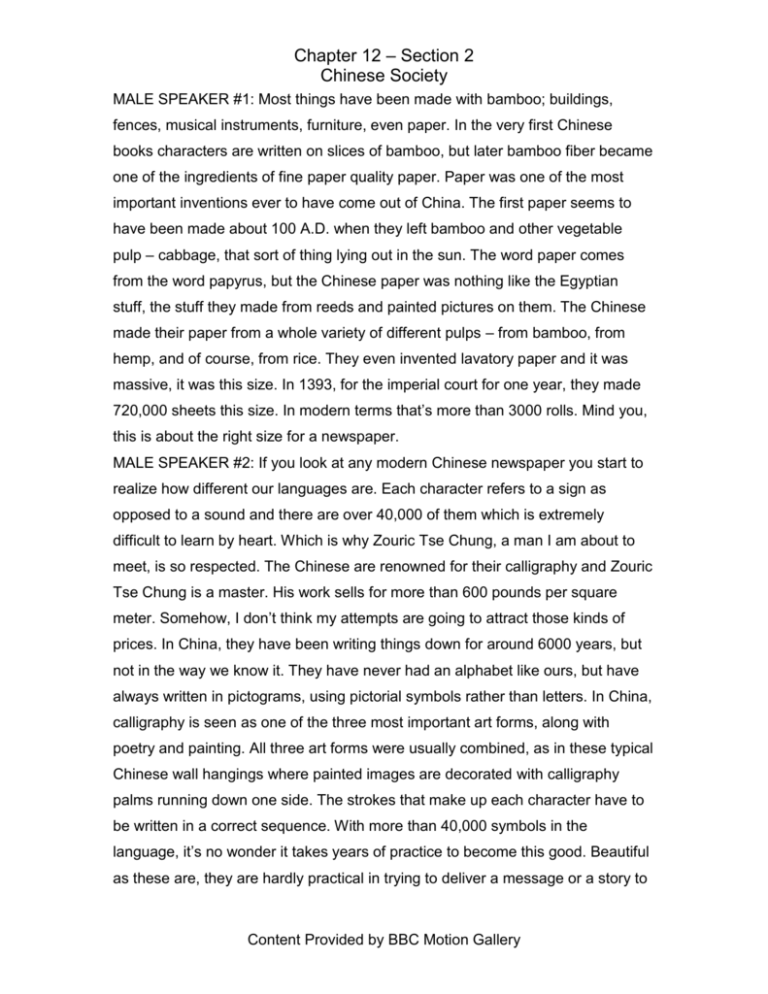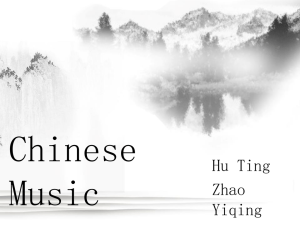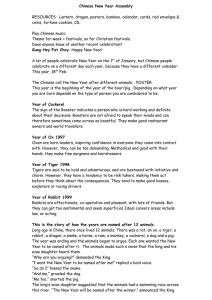Chapter 12 - Section 2 - Chinese Society
advertisement

Chapter 12 – Section 2 Chinese Society MALE SPEAKER #1: Most things have been made with bamboo; buildings, fences, musical instruments, furniture, even paper. In the very first Chinese books characters are written on slices of bamboo, but later bamboo fiber became one of the ingredients of fine paper quality paper. Paper was one of the most important inventions ever to have come out of China. The first paper seems to have been made about 100 A.D. when they left bamboo and other vegetable pulp – cabbage, that sort of thing lying out in the sun. The word paper comes from the word papyrus, but the Chinese paper was nothing like the Egyptian stuff, the stuff they made from reeds and painted pictures on them. The Chinese made their paper from a whole variety of different pulps – from bamboo, from hemp, and of course, from rice. They even invented lavatory paper and it was massive, it was this size. In 1393, for the imperial court for one year, they made 720,000 sheets this size. In modern terms that’s more than 3000 rolls. Mind you, this is about the right size for a newspaper. MALE SPEAKER #2: If you look at any modern Chinese newspaper you start to realize how different our languages are. Each character refers to a sign as opposed to a sound and there are over 40,000 of them which is extremely difficult to learn by heart. Which is why Zouric Tse Chung, a man I am about to meet, is so respected. The Chinese are renowned for their calligraphy and Zouric Tse Chung is a master. His work sells for more than 600 pounds per square meter. Somehow, I don’t think my attempts are going to attract those kinds of prices. In China, they have been writing things down for around 6000 years, but not in the way we know it. They have never had an alphabet like ours, but have always written in pictograms, using pictorial symbols rather than letters. In China, calligraphy is seen as one of the three most important art forms, along with poetry and painting. All three art forms were usually combined, as in these typical Chinese wall hangings where painted images are decorated with calligraphy palms running down one side. The strokes that make up each character have to be written in a correct sequence. With more than 40,000 symbols in the language, it’s no wonder it takes years of practice to become this good. Beautiful as these are, they are hardly practical in trying to deliver a message or a story to Content Provided by BBC Motion Gallery Chapter 12 – Section 2 Chinese Society the masses. Imagine how long it would have taken to write one of Confucius’ sayings. But the Chinese came up with a novel idea for mass producing print, by simply taking blocks of wood and carving their character into them. They invented block printing. Buddhist monks were the first to use the block print to spread their sutras, their religious texts among the believers. The oldest dated block printed book is the Buddhist diamond sutra from the year 868 and in the next century they block printed the Confucian classics, carving entire pages of script onto each block. And not just script, but pictures as well! Content Provided by BBC Motion Gallery






